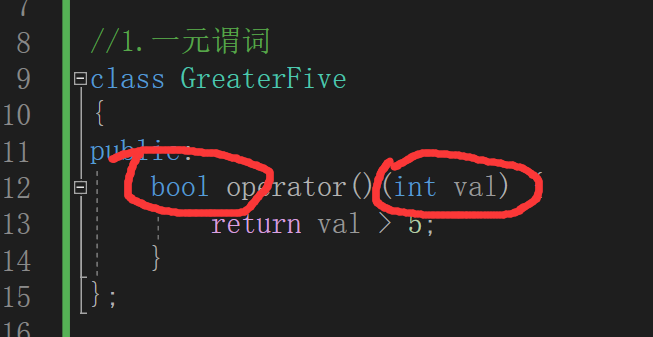1、函数对象(仿函数)
1.1、函数对象概念
概念:
- 重载函数调用操作符()的类,其对象常称为函数对象
- 函数对象使用重载的()时,行为类似函数调用,也叫仿函数
本质:
函数对象(仿函数)是一个类,不是一个函数
1.2、函数对象使用
特点:
- 函数对象在使用时,可以像普通函数那样调用, 可以有参数,可以有返回值
- 函数对象超出普通函数的概念,函数对象可以有自己的状态
- 函数对象可以作为参数传递
#include <iostream>
using namespace std;
#include <string>
//函数对象 (仿函数)
//● 函数对象在使用时,可以像普通函数那样调用, 可以有参数,可以有返回值
//● 函数对象超出普通函数的概念,函数对象可以有自己的状态
//● 函数对象可以作为参数传递
//1、函数对象在使用时,可以像普通函数那样调用, 可以有参数,可以有返回值
class MyAdd
{
public:
int operator()(int v1, int v2)
{
return v1 + v2;
}
};
void test01()
{
MyAdd myAdd;
cout << myAdd(10, 10) << endl;
}
//2、函数对象可以有自己的状态
class MyPrint
{
public:
MyPrint()
{
count = 0;
}
void operator()(string test)
{
cout << test << endl;
count++; //统计使用次数
}
int count; //内部自己的状态
};
void test02()
{
MyPrint myPrint;
myPrint("hello world");
myPrint("hello world");
myPrint("hello world");
cout << "myPrint调用次数为: " << myPrint.count << endl;
}
//3、函数对象可以作为参数传递
void doPrint(MyPrint& mp, string test)
{
mp(test);
}
void test03()
{
MyPrint myPrint;
doPrint(myPrint, "Hello C++");
}
int main()
{
//test01();
//test02();
test03();
system("pause");
return 0;
}
总结:仿函数写法非常灵活,可以作为参数进行传递
2、谓词
2.1、谓词概念
概念:
- 返回bool类型的仿函数称为谓词
- 如果operator()接受一个参数,那么叫做一元谓词
- 如果operator()接受两个参数,那么叫做二元谓词
2.2、一元谓词
#include <iostream>
using namespace std;
#include <vector>
#include <algorithm>
//仿函数——返回值类型是bool数据类型,称为谓词
//1.一元谓词
class GreaterFive
{
public:
bool operator()(int val) {
return val > 5;
}
};
void test01() {
vector<int> v;
for (int i = 0; i < 10; i++)
{
v.push_back(i);
}
//查找容器中 有没有大于5的数字
//GreaterFive() 匿名函数对象
vector<int>::iterator it = find_if(v.begin(), v.end(), GreaterFive());
if (it == v.end()) {
cout << "没找到!" << endl;
}
else {
cout << "找到:" << *it << endl;
}
}
int main()
{
test01();
system("pause");
return 0;
}
总结:参数只有一个的谓词,称为一元谓词

拓展:find_if用于按条件寻找有没有符合条件的数据(需要第一个参数,最后一个参数和谓词)需要添加算法头文件algorithm
扫描二维码关注公众号,回复:
17357468 查看本文章



2.3、二元谓词
#include <iostream>
using namespace std;
#include <vector>
#include <algorithm>
//二元谓词
class MyCompare
{
public:
bool operator()(int num1, int num2)
{
return num1 > num2;
}
};
void test01()
{
vector<int> v;
v.push_back(10);
v.push_back(40);
v.push_back(20);
v.push_back(30);
v.push_back(50);
//默认从小到大
sort(v.begin(), v.end());
for (vector<int>::iterator it = v.begin(); it != v.end(); it++)
{
cout << *it << " ";
}
cout << endl;
cout << "----------------------------" << endl;
//使用函数对象改变算法策略,排序从大到小
sort(v.begin(), v.end(), MyCompare());
for (vector<int>::iterator it = v.begin(); it != v.end(); it++)
{
cout << *it << " ";
}
cout << endl;
}
int main()
{
test01();
system("pause");
return 0;
}
总结:只有两个的谓词,称为二元谓词

3、内建函数对象
3.1、内建函数对象意义
概念:
- STL内建了一些函数对象
分类:
- 算术仿函数
- 关系仿函数
- 逻辑仿函数
用法:
- 这些仿函数所产生的对象,用法和一般函数完全相同
- 使用内建函数对象,需要引入头文件 #include<functional>
3.2、算数仿函数
功能描述:
- 实现四则运算
- 其中negate是一元运算,其他都是二元运算
仿函数原型:
template<class T> T plus<T>//加法仿函数template<class T> T minus<T>//减法仿函数template<class T> T multiplies<T>//乘法仿函数template<class T> T divides<T>//除法仿函数template<class T> T modulus<T>//取模仿函数template<class T> T negate<T>//取反仿函数
#include <iostream>
using namespace std;
#include <functional>
//内建函数对象 算数仿函数
//negate 一元仿函数 取反仿函数
void test01()
{
negate<int> n;
cout << n(50) << endl;
}
//plus 二元仿函数 加法仿函数
void test02()
{
plus<int> p;
cout << p(10, 20) << endl;
}
int main()
{
test01();
test02();
system("pause");
return 0;
}
总结:
- 使用内建函数对象时,需要引入头文件
#include <functional> - 在模板参数列表中写一个参数类型即可,因为他只允许同种类型的数据进行处理

3.3、关系仿函数
功能描述:
- 实现关系对比
仿函数原型:
template<class T> bool equal_to<T>//等于template<class T> bool not_equal_to<T>//不等于template<class T> bool greater<T>//大于template<class T> bool greater_equal<T>//大于等于template<class T> bool less<T>//小于template<class T> bool less_equal<T>//小于等于
#include <iostream>
using namespace std;
#include <functional>
#include <vector>
#include <algorithm>
//内建函数对象 关系仿函数
class MyCompare
{
public:
bool operator()(int v1, int v2)
{
return v1 > v2;
}
};
void test01()
{
vector<int> v;
v.push_back(10);
v.push_back(30);
v.push_back(50);
v.push_back(40);
v.push_back(20);
for (vector<int>::iterator it = v.begin(); it != v.end(); it++) {
cout << *it << " ";
}
cout << endl;
//自己实现仿函数
//sort(v.begin(), v.end(), MyCompare());
//STL内建仿函数 大于仿函数
sort(v.begin(), v.end(), greater<int>());
for (vector<int>::iterator it = v.begin(); it != v.end(); it++) {
cout << *it << " ";
}
cout << endl;
}
int main()
{
test01();
system("pause");
return 0;
}
总结:
关系仿函数中最常使用的就是greater<>大于
排序可以使用自己实现仿函数,也可以通过STL内置仿函数

3.4、逻辑仿函数
功能描述:
- 实现逻辑运算
函数原型:
template<class T> bool logical_and<T>//逻辑与template<class T> bool logical_or<T>//逻辑或template<class T> bool logical_not<T>//逻辑非
#include <iostream>
using namespace std;
#include <vector>
#include <functional>
#include <algorithm>
//内建函数对象 逻辑仿函数
//逻辑非 logical_not
void test01()
{
vector<bool> v;
v.push_back(true);
v.push_back(false);
v.push_back(true);
v.push_back(false);
for (vector<bool>::iterator it = v.begin(); it != v.end(); it++)
{
cout << *it << " ";
}
cout << endl;
//逻辑非 将v容器搬运到v2中,并执行逻辑非运算
vector<bool> v2;
v2.resize(v.size());
transform(v.begin(), v.end(), v2.begin(), logical_not<bool>());
for (vector<bool>::iterator it = v2.begin(); it != v2.end(); it++)
{
cout << *it << " ";
}
cout << endl;
}
int main()
{
test01();
system("pause");
return 0;
}
总结:逻辑仿函数实际应用较少,了解即可
(注意:在搬运的时候一定要指定另一个容器的容量,因为我们没有插入数据,而是直接搬运,不指定容量的话是不会有空间的)

拓展:
transform()函数,把第一个容器的开头到结尾搬到第二个容器,并从第二个容器的开头开始执行逻辑非操作。
